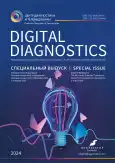Применение модернизированного вейвлет-преобразования для выделения динамики изменения длительности интервалов при электрокардиографической диагностике
- Авторы: Алали Ш.1, Балакин Д.А.1
-
Учреждения:
- Национальный исследовательский университет "МЭИ"
- Выпуск: Том 5, № 1S (2024)
- Страницы: 56-58
- Раздел: МОЛОДЫЕ УЧЕНЫЕ: тезисы конференции НПКЦ
- URL: https://journals.rcsi.science/DD/article/view/261098
- DOI: https://doi.org/10.17816/DD626185
- ID: 261098
Цитировать
Полный текст
Аннотация
Обоснование. Заболевания сердечно-сосудистой системы являются основной причиной смерти во всём мире [1]. Многие медицинские диагнозы основаны на оценке характерных точек в электрокардиографическом сигнале. Например, двумя важными временными интервалами являются P–R и Q–T, которые оказывают существенное влияние на состояние здоровья пациента [2].
Однако минимальные изменения амплитуд и интервалов между волнами во времени трудно обнаружить простым визуальным осмотром. Задача усложняется тем, что нет чётко установленного правила определения начала и конца Q–T интервала, кроме того, продолжительность интервалов изменяется с каждым сердечным сокращением [3].
Цель — разработка алгоритма, позволяющего выделить динамику изменения длительности интервалов при анализе электрокардиографических сигналов.
Материалы и методы. В качестве рабочего инструмента выступает вейвлет-преобразование. Благодаря своей способности разлагать сигналы на хорошо локализованные базисные функции, вейвлет-преобразование хорошо подходит для того, чтобы отличать электрокардиографические волны от шума [4]. Кроме того, за счёт возможности изменения масштаба можно не только обнаружить различные локальные неоднородности в электрокардиографическом сигнале, но и выявить их длительности.
Одна из основных проблем при использовании вейвлет-преобразования — это выбор материнской функции. В работе предлагается использовать преобразование Эрмита [5], благодаря которому можно сконструировать материнскую функцию произвольной формы, что повышает эффективность обнаружения. Кроме того, преобразование Эрмита можно применить к реальной записи электрокардиографического сигнала, что позволяет сохранить характерные особенности сигнала пациента.
Результаты. Результатом работы алгоритма является набор ритмограмм, каждая из которых прослеживает изменения во времени интервалов электрокардиографического сигнала, например, P–R или Q–T. Ритмограмма является стохастической характеристикой, позволяющей оценить дисперсию Q–T интервалов даже в течение непродолжительных временных отрезков и при смене уровня физической активности. Именно поэтому, применяя статистический аппарат, можно количественно оценить эффективность диагностики предлагаемого алгоритма обработки.
Заключение. В докладе представлены основные выводы работы алгоритма и результаты обработки модельных электрокардиографических сигналов.
Полный текст
Открыть статью на сайте журналаОб авторах
Шариф Алали
Национальный исследовательский университет "МЭИ"
Автор, ответственный за переписку.
Email: alali.charif.1@mail.ru
ORCID iD: 0000-0001-8894-4257
Россия, Москва
Дмитрий Александрович Балакин
Национальный исследовательский университет "МЭИ"
Email: dabalakin@yandex.ru
ORCID iD: 0000-0003-0497-7153
SPIN-код: 1722-7110
Россия, Москва
Список литературы
- Dattani S., Samborska V., Ritchie H., Roser M. Cardiovascular Diseases [Internet]. Our World In Data (UK); 2023. Доступ по ссылке: https://ourworldindata.org/cardiovascular-diseases
- Клинические рекомендации — Брадиаритмии. Утверждены ФГБУ «НМИЦ ССХ им. А.Н. Бакулева». 2017.
- Колоцей Л.В., Снежицкий В.А. Методологические подходы к измерению и оценке длительности интервала QT стандартной электрокардиограммы // Журнал Гродненского государственного медицинского университета. 2019. Т. 17, № 1. С. 99–105. EDN: YZJVZB doi: 10.25298/2221-8785-2019-17-1-99-105
- Alfaouri M., Daqrouq K. ECG Signal Denoising By Wavelet Transform Thresholding // American Journal of Applied Sciences. 2008. Vol. 5, N 3. P. 276–281. doi: doi.org/10.3844/ajassp.2008.276.281
- Balakin D.A. Analysis of electrocardiographic signals using a new method based on the principles of wavelet processing and Gauss-Hermit functions // Conference: 2022 6th International Scientific Conference on Information, Control, and Communication Technologies (ICCT); 2022; Astrakhan. doi: 10.1109/ICCT56057.2022.9976684
Дополнительные файлы









